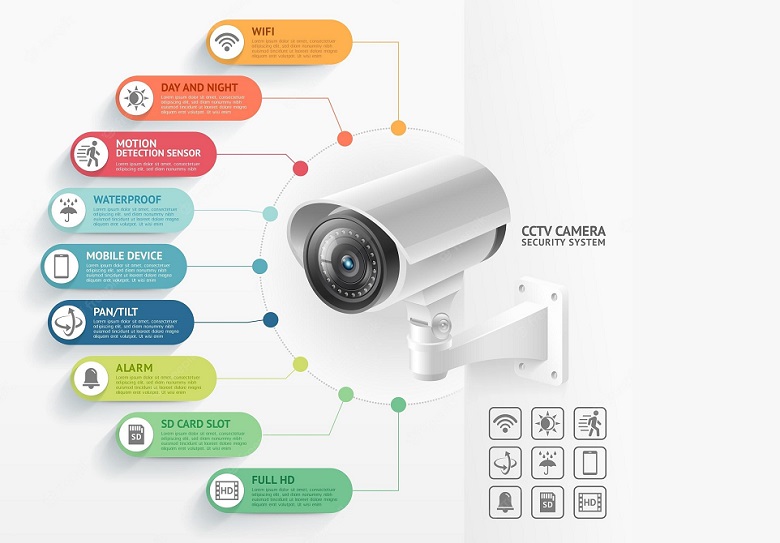Home security cameras are one of the most effective ways of protecting your home and loved ones. With the right setup, they’ll alert you to any intruders or other threats, giving you time to react before anyone gets hurt. In this post, we’ll explore what you need to know about home security cameras and how they can help you keep your home safe.
What is a Home Security Camera?
A home security camera is a device that records and transmits video footage. It can be used to monitor a specific area (like your front door or backyard), or keep an eye on the entire home. The video footage can be viewed from a computer, smartphone, or other device — making security cameras an accessible and effective solution for protecting your home. While many cameras are designed for indoor use, there are a few models that are made for outdoor use — particularly those with weatherproof or water-resistant designs. There are also specialty cameras designed for specific purposes, like traffic monitoring or keeping an eye on pets or children.
How do home security cameras work?
Home security cameras work by recording images or video whenever something is detected in the camera’s field of view — like a person approaching your home or an intruder breaking in. The camera can either record continuously or when motion is detected. It then transmits the recorded footage to a computer or other device where you can view it and take action as necessary. Most security cameras can also send an alert when motion is detected in the recorded footage. This can be helpful if you want to be alerted to any disturbances, but don’t need to view the footage right away. The alert can also include a photo of the intruder, if the camera has this feature.
Why use home security cameras?
Home security cameras can give you real-time information about what’s happening in your home — whether you’re nearby or halfway across the globe. This can help you catch criminals in the act, or identify issues that need to be addressed immediately. The most effective way to use home security cameras is to install them in areas where you want to monitor foot traffic. This includes your front door, backyard, and other common entry points. It’s also a good idea to keep an eye on your property line, since this is where an intruder will likely cut their way through the brush.
Home security cameras can also be useful for monitoring your kids or pets. You can keep an eye on your loved ones to make sure they stay safe and out of harm’s way. You can also use the footage to establish patterns and see what areas of the house or yard they frequent the most. This can help you keep your kids safe, as well as avoid unnecessary trips outside during mosquito season.
Types of Home Security Cameras
There are a variety of home security cameras on the market, each with its own set of features and benefits. Here are a few of the most common types of cameras.
Indoor cameras
These are good for monitoring foot traffic in your living room, kitchen, or other indoor areas.
Outdoor cameras
These can be used to monitor your property line and keep an eye on outdoor activity.
Specialty cameras
These are built specifically for a certain purpose. This can include monitoring a specific object or keeping an eye on pets or children. Indoor cameras are good for keeping an eye on indoor foot traffic, like in your front or back door. They’re also good for monitoring indoor activities like sewing, knitting, or other crafts. Outdoor cameras are a good choice if you want to monitor your property line or track activity on your lawn. You can also use an outdoor camera to keep an eye on your backyard, porch, or other outdoor areas. Specialty cameras are designed for a specific purpose — like monitoring a single object or keeping an eye on pets or children. You may also find indoor cameras designed for specific purposes, like monitoring a fish tank or aquarium.
Installing a Home Security Camera
Installing a home security camera is easier than you might think, but it’s important to choose the right model. The first step is to decide where you want to place the camera and what you want to monitor. Once you’ve chosen the right location, you’ll need to decide on a model. There are a few things to keep in mind when choosing a camera.
Wired or wireless
Most cameras are wireless and can be easily installed without wires. This can reduce clutter and simplify the installation process.
Image resolution
Image resolution refers to the clarity of the recorded footage. Higher resolution images are better for identifying specific details, like clothing or facial features.
Field of vision
The field of vision is the width of the area that the camera can see. This is usually noted in degrees or a percentage. A wider field of vision will let you monitor more activity at once.
Camera type
There are a few different types of cameras — like bullet or dome cameras — and each has its own benefits. Bullet cameras are a good all-around choice, while dome cameras are a good choice if you want to monitor a specific object.
It can be tricky getting the correct set-up. There’s nothing worse than having intruders in your home who aren’t identifiable due to poorly placed cameras. This is more common than you thing. If you have any doubts, contact professional security camera installers.
Tips for Using Home Security Cameras
There are a few things you should keep in mind when using home security cameras. These tips will help you get the most out of your cameras and protect your home from intruders.
Position
It’s important to place your cameras in areas that will best protect your home. This includes placing cameras where they can monitor foot traffic at entry points, and behind bushes or shrubs where intruders might approach your property.
Field of vision
Make sure the field of vision on each camera covers the areas you want to monitor. It’s also important to make sure that each camera can clearly see other cameras in the area — otherwise, they won’t be able to transmit footage.
Camera sensitivity
It’s important to adjust the camera sensitivity so that it alerts you to real threats, but doesn’t give false alarms. If a camera is set too sensitive, it might pick up false alarms from the wind, a nearby tree, or other natural sources. You can also block out areas where you expect constant movement (eg trees) and leave areas you want to detect (eg driveway, doorway).
Nightvision
There’s a fair chance that intruders are going to try and invade your property under the cover of darkness. Cameras these days have impressive night vision. Some security cameras have starlight night vision that delivers crisp night images. They’re so much better than the grainy black and white vision of past years.
Conclusion
Home security cameras are an important part of any home security strategy. They can help you keep an eye on your property line and catch intruders in the act — giving you a chance to catch the culprit and avoid a costly break-in. Many cameras can be wired or wireless, making them easy to install where you need them most. You can then view the footage from your computer or other device to keep an eye on your home. It’s important to choose the right camera for your needs, and make sure the camera is correctly positioned to monitor the areas you want to protect.

